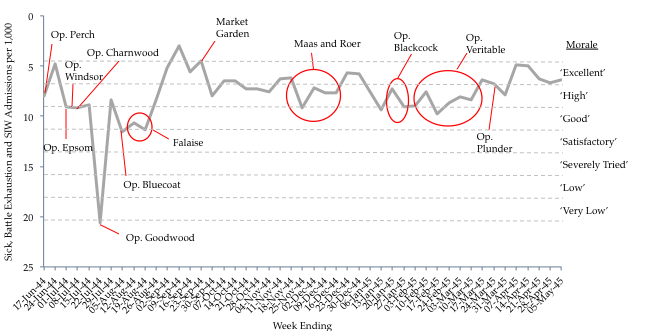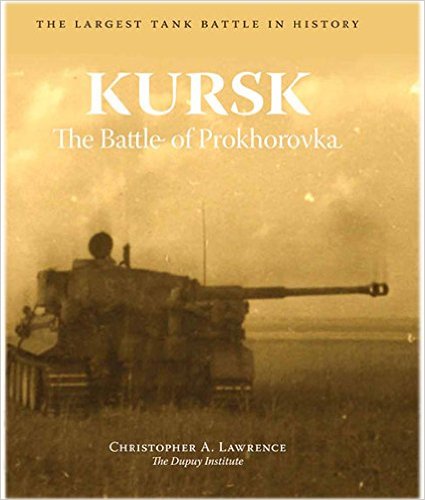 Dr. Reina Pennington, a professor of history at Norwich University, recently published an analysis of the Eastern Front during World War II which made the case that the Soviet superiority in manpower over Germany was not as large as is often claimed. In support of her argument, Pennington provided a table comparing the total number of Soviet and German combat forces and force ratios at different times during the conflict. She pointed out that for much of the war, Soviet forces were either outnumbered, or achieved modest numerical superiorities that did not exceed 3 to 1 until late in 1944. “A 2:1 advantage is significant,” Pennington argued, “but falls short of the 3:1 force ratio that is generally regarded as necessary for attacking forces, and it’s a long way from the double-digit advantage that is often claimed.”
Dr. Reina Pennington, a professor of history at Norwich University, recently published an analysis of the Eastern Front during World War II which made the case that the Soviet superiority in manpower over Germany was not as large as is often claimed. In support of her argument, Pennington provided a table comparing the total number of Soviet and German combat forces and force ratios at different times during the conflict. She pointed out that for much of the war, Soviet forces were either outnumbered, or achieved modest numerical superiorities that did not exceed 3 to 1 until late in 1944. “A 2:1 advantage is significant,” Pennington argued, “but falls short of the 3:1 force ratio that is generally regarded as necessary for attacking forces, and it’s a long way from the double-digit advantage that is often claimed.”
To support her assertion of the relevance of the 3-1 force ratio, Pennington linked to an article by Trevor N. Dupuy, “Combat Data and the 3:1 Rule,” published in the summer 1989 edition of International Security. The problem with citing Dupuy is that his assessment of the 3-1 rule contradicts her assertion of it.
Dupuy criticized the 3-1 rule on empirical grounds. The so-called “3-1 rule” is a military aphorism that holds that attacking forces require a 3 to 1 advantage over defending forces in order to succeed. Although this rule has become widely-known and widely-held, especially in Western militaries, its origin is unknown and unattributed. It is not exactly clear to what exactly it refers, and there is no known original statement of the rule that can be consulted for clarification.
Dupuy questioned the ambiguity of the rule, which in turn undermined its relevance.
[W]hat is the force ratio to be used with the 3:1 force ratio planning factor? Is it numbers of men, or weapons? Is it firepower? Is it some other calculation of a combat power ratio? In any event, it is clear that neither numbers nor firepower tells us much unless we know the circumstances under which these numbers face each other and the manner in which the firepower is applied.[1]
In 1984, Dupuy’s Historical Evaluation Research Organization (HERO) compiled a database of battles from 1600 to 1973 for the U.S. Army Concepts Analysis Agency (CAA; now known as the U.S. Army Center for Army Analysis). CAA’s examination of the numerical force ratios in the database showed that attackers with advantages of 3-1 or more in manpower succeeded 74% of the time. It also showed that attackers won between 58% and 63% of the time when attacking with between a 1.5-1 numerical disadvantage and less than a 3-1 advantage. Attackers also managed to obtain a manpower advantage of 3-1 or greater in just 106 of 598 cases (17.7%) examined.[2]

Dupuy concurred that a 3-1 ratio based on a simple numerical total of troop numbers had limited use as a general rule-of-thumb guide for military planning, but asserted that it was useless for analytical purposes Simply put, while there are many historical cases where an attacking force with a 3-1 numerical advantage succeeded, there are also many cases where attackers won with less than a 3-1 advantage, and even with a numerical inferiority. On the Eastern Front during World War II, for example, the German Army regularly conducted successful attacks against numerically superior Soviet forces.
Dupuy was so certain of the validity of the data on this that he made it an aphorism of his own: In the average modem battle, the attacker’s numerical strength is about double the defender’s.
This is because the attacker has the initiative and can initiate combat at a time and place of his choosing and in the manner of his choosing. The attacker can mass his forces at critical points on the battlefield to gain the advantage in strength which he believes necessary to assure the success of the attack.
A battle usually does not take place unless each side believes it has some chance for success. Otherwise, the attacker would avoid taking the initiative. The defender, if he could not avoid battle by withdrawal, would make every possible effort to reinforce the prospective battle area sufficiently to have a chance for successful defense. One circumstance in which a battle occurs without the tacit agreement or acceptance of the defender, is when the attacker achieves surprise. Alternatively, surprise by a defender (for instance, by ambush) may result in a battle taking place before the prospective attacker is ready.
Most military men are aware of the rule of thumb that an attacker can count on success if he has a three-to-one numerical superiority, while a defender can expect success if his inferiority is not less than one-to-two. But the side achieving surprise can count on the effects of surprise multiplying its force strength by a factor ranging between 1.5 and 2.5 (or even more in some cases). Thus, an attacker expecting to achieve surprise would be willing to attack with less than a three-to-one superiority.
Another factor which can influence an attacker to seek battle with less than a three-to-one superiority is confidence in the superior quality of his troops. This accounts for many instances in which the Germans attacked in World War II with less than the desirable numerical superiority, and for the similar instances of Israeli attacks in the Arab-Israeli wars without great numerical superiority.[3]
Dr. Pennington is on fairly firm ground in rejecting the idea that numerical superiority was the sole reason the Red Army defeated the German Army in World War II, but numbers did play an extremely important role in the Soviet success. The lack of a 3-1 manpower advantage did not preclude the Soviets from battlefield success; 2-1 was sufficient. By the time the Soviets achieved a 3-1 advantage, success was well in hand and the end in sight.
NOTES
[1] Trevor N. Dupuy. Numbers, Predictions and War: Using History to Evaluate Combat Factors and Predict the Outcome of Battles. Indianapolis; New York: The Bobbs-Merrill Co., 1979, p. 13
[2] Joshua M. Epstein, “Dynamic Analysis and the Conventional Balance in Europe,” International Security, Spring 1988, p. 156; Robert Helmbold and Aqeel A. Khan. “Combat History Analysis Study Effort (CHASE): Progress Report for the Period August 1984-June 1985,” Bethesda, MD: U.S. Army Concepts Analysis Agency, August 1986
[3] Trevor N. Dupuy. Attrition: Forecasting Battle Casualties and Equipment Losses in Modern War. Falls Church (VA): Nova Publications, 1995, pp. 98-99
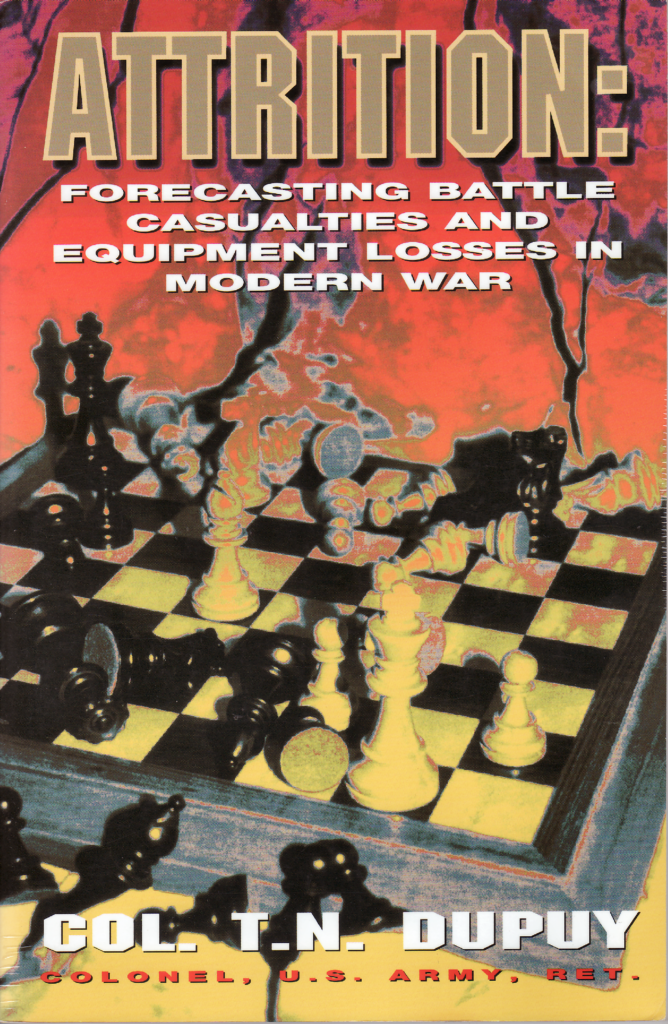 In his 1990 book Attrition: Forecasting Battle Casualties and Equipment Losses in Modern War, Trevor Dupuy took a look at the relationship between tank losses and crew casualties in the U.S. 1st Army between June 1944 and May 1945 (pp. 80-81). The data sampled included 797 medium (averaging 5 crewmen) and 101 light (averaging 4 crewmen) tanks. For each tank loss, an average of one crewman was killed or wounded. Interestingly, although gunfire accounted for the most tank and crew casualties, infantry anti-tank rockets (such as the Panzerfaust) inflicted 13% of the tank losses, but caused 21% of the crew losses.
In his 1990 book Attrition: Forecasting Battle Casualties and Equipment Losses in Modern War, Trevor Dupuy took a look at the relationship between tank losses and crew casualties in the U.S. 1st Army between June 1944 and May 1945 (pp. 80-81). The data sampled included 797 medium (averaging 5 crewmen) and 101 light (averaging 4 crewmen) tanks. For each tank loss, an average of one crewman was killed or wounded. Interestingly, although gunfire accounted for the most tank and crew casualties, infantry anti-tank rockets (such as the Panzerfaust) inflicted 13% of the tank losses, but caused 21% of the crew losses. Casualties were evenly distributed among the crew positions.
Casualties were evenly distributed among the crew positions.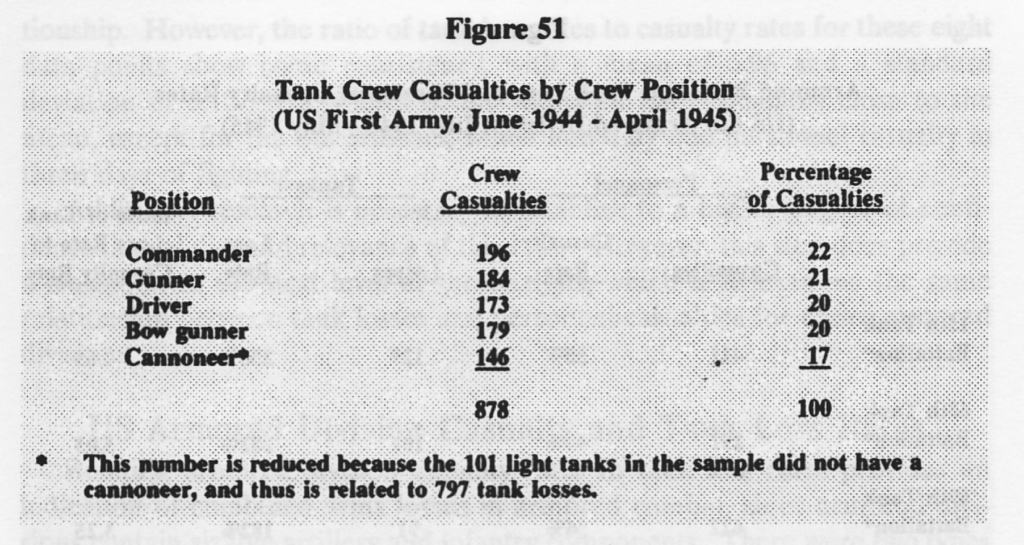 Whether or not a destroyed tank caught fire made a big difference for the crew. Only 40% of the tanks in the sample burned, but casualties were distributed evenly between the tanks that burned and those that did not. This was due to the higher casualty rate in the tanks that caught fire (1.28 crew casualties per tank) and those that did not (0.78 casualties per tank).
Whether or not a destroyed tank caught fire made a big difference for the crew. Only 40% of the tanks in the sample burned, but casualties were distributed evenly between the tanks that burned and those that did not. This was due to the higher casualty rate in the tanks that caught fire (1.28 crew casualties per tank) and those that did not (0.78 casualties per tank).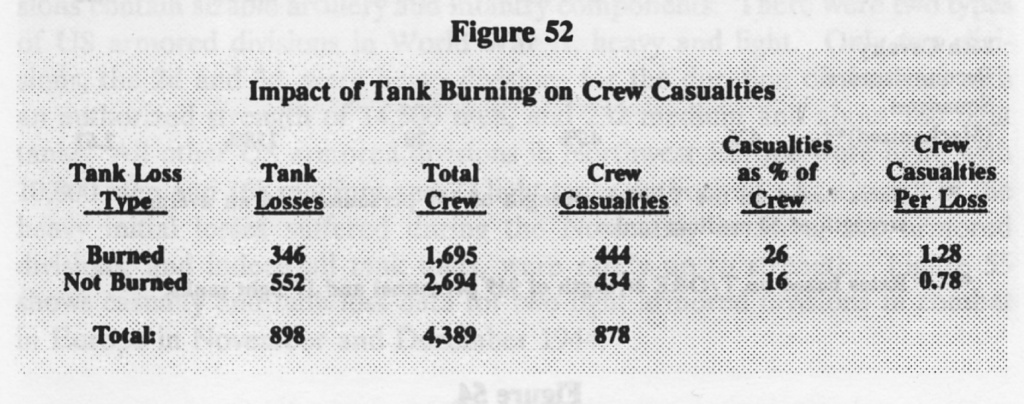 Dupuy found the relationship between tank losses and casualties to be straightforward and obvious. This relationship would not be so simple when viewed at the battalion level. More on that in a future post [Tank Loss Rates in Combat: Then and Now].
Dupuy found the relationship between tank losses and casualties to be straightforward and obvious. This relationship would not be so simple when viewed at the battalion level. More on that in a future post [Tank Loss Rates in Combat: Then and Now].
 Dr. Reina Pennington, a professor of history at Norwich University,
Dr. Reina Pennington, a professor of history at Norwich University, 
![British Mark III Tank in ditch, 1917 [Wikimedia Commons]](https://dupuyinstitute.dreamhosters.com/wp-content/uploads/2016/06/British-Mark-III-Tank-in-ditch-1917.jpg)
